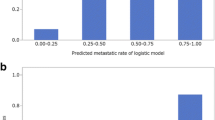Abstract
Objective
This study was designed to evaluate the diagnostic accuracy of magnetic resonance imaging (MRI) for lateral pelvic lymph-node metastasis.
Patients
Eighty-four patients with primary lower rectal cancer were examined by MRI and subsequently underwent radical surgery with lateral pelvic lymph-node dissection, without preoperative treatment. Lateral lymph-node metastases were assessed preoperatively by MRI, and the results were compared with the histopathological findings. The criterion for lateral lymph-node metastasis was any recognizable lymph node in the pelvic wall, regardless of diameter.
Result
Lateral pelvic lymph-node metastasis was diagnosed on preoperative MRI in 16 patients (19.9 %). The overall patient-based sensitivity, specificity, positive predictive value, negative predictive value, and accuracy of MRI were 75, 69.1, 36.4, 92.2, and 70.2 %, respectively. When a cut-off value of 10 mm was used for diagnosis, the corresponding values were 43.8, 98.5, 87.5, 88.1, and 88.1 %, respectively. The mean diameter of metastatic nodes (14.7 mm) was significantly larger than that of negative nodes (5.7 mm; P < 0.01).
Conclusion
MRI is an effective technique for predicting lateral pelvic node involvement and thus may facilitate preoperative decision-making in rectal cancer treatment. A cut-off value of 10 mm is useful for avoiding unnecessary lateral lymph-node dissection.






Similar content being viewed by others
References
Heald RJ, Ryall RD (1986) Recurrence and survival after total mesorectal excision for rectal cancer. Lancet 1(8496):1479–1482
Arbman G, Nilsson E, Hallbook O, Sjodahl R (1996) Local recurrence following total mesorectal excision for rectal cancer. Br J Surg 83(3):375–379
van Gijn W, Marijnen CA, Nagtegaal ID et al (2011) Preoperative radiotherapy combined with total mesorectal excision for resectable rectal cancer: 12-year follow-up of the multicentre, randomised controlled TME trial. Lancet Oncol 12(6):575–582
Sauer R, Becker H, Hohenberger W et al (2004) Preoperative versus postoperative chemoradiotherapy for rectal cancer. N Engl J Med 351(17):1731–1740
Takahashi T, Ueno M, Azekura K, Ohta H (2000) Lateral node dissection and total mesorectal excision for rectal cancer. Dis Colon Rectum 43(10 Suppl):S59–S68
Moriya Y, Sugihara K, Akasu T, Fujita S (1997) Importance of extended lymphadenectomy with lateral node dissection for advanced lower rectal cancer. World J Surg 21(7):728–732. doi:10.1007/s002689900298
Ueno H, Mochizuki H, Hashiguchi Y et al (2007) Potential prognostic benefit of lateral pelvic node dissection for rectal cancer located below the peritoneal reflection. Ann Surg 245(1):80–87
Akasu T, Sugihara K, Moriya Y (2009) Male urinary and sexual functions after mesorectal excision alone or in combination with extended lateral pelvic lymph node dissection for rectal cancer. Ann Surg Oncol 16(10):2779–2786
Mizukami Y, Ueda S, Mizumoto A et al (2011) Diffusion-weighted magnetic resonance imaging for detecting lymph node metastasis of rectal cancer. World J Surg 35(4):895–899. doi:10.1007/s00268-011-0986-x
LeBlanc JK (2007) Imaging and management of rectal cancer. Nat Clin Pract Gastroenterol Hepatol 4(12):665–676
Lahaye MJ, Engelen SM, Nelemans PJ et al (2005) Imaging for predicting the risk factors–the circumferential resection margin and nodal disease–of local recurrence in rectal cancer: a meta-analysis. Semin Ultrasound CT MR 26(4):259–268
Goligher JCDH, Nixon HH (1984) Surgery of the anus, rectum and colon, 5th edn. Bailliere Tindall, London
General rules for clinical and pathological studies on cancer of the colon, rectum and anus. Part I. Clinical classification. Japanese Research Society for Cancer of the Colon and Rectum. Jpn J Surg 13(6):557–573 (1983)
Moriya Y, Hojo K, Sawada T, Koyama Y (1989) Significance of lateral node dissection for advanced rectal carcinoma at or below the peritoneal reflection. Dis Colon Rectum 32(4):307–315
Ueno M, Oya M, Azekura K, Yamaguchi T, Muto T (2005) Incidence and prognostic significance of lateral lymph node metastasis in patients with advanced low rectal cancer. Br J Surg 92(6):756–763
Hojo K, Koyama Y, Moriya Y (1982) Lymphatic spread and its prognostic value in patients with rectal cancer. Am J Surg 144(3):350–354
Lambregts DM, Beets GL, Maas M et al (2011) Accuracy of gadofosveset-enhanced MRI for nodal staging and restaging in rectal cancer. Ann Surg 253(3):539–545
Brown G, Radcliffe AG, Newcombe RG, Dallimore NS, Bourne MW, Williams GT (2003) Preoperative assessment of prognostic factors in rectal cancer using high-resolution magnetic resonance imaging. Br J Surg 90(3):355–364
Brown G, Richards CJ, Bourne MW et al (2003) Morphologic predictors of lymph node status in rectal cancer with use of high-spatial-resolution MR imaging with histopathologic comparison. Radiology 227(2):371–377
Gearhart SL, Frassica D, Rosen R, Choti M, Schulick R, Wahl R (2006) Improved staging with pretreatment positron emission tomography/computed tomography in low rectal cancer. Ann Surg Oncol 13(3):397–404
Heriot AG, Hicks RJ, Drummond EG et al (2004) Does positron emission tomography change management in primary rectal cancer? A prospective assessment. Dis Colon Rectum 47(4):451–458
Kusunoki M, Yanagi H, Kamikonya N et al (1994) Preoperative detection of local extension of carcinoma of the rectum using magnetic resonance imaging. J Am Coll Surg 179(6):653–656
Indinnimeo M, Grasso RF, Cicchini C et al (1996) Endorectal magnetic resonance imaging in the preoperative staging of rectal tumors. Int Surg 81(4):419–422
Author information
Authors and Affiliations
Corresponding author
Ethics declarations
Conflicts of interest
There is no grant support and no conflicts of interest.
Rights and permissions
About this article
Cite this article
Ishibe, A., Ota, M., Watanabe, J. et al. Prediction of Lateral Pelvic Lymph-Node Metastasis in Low Rectal Cancer by Magnetic Resonance Imaging. World J Surg 40, 995–1001 (2016). https://doi.org/10.1007/s00268-015-3299-7
Published:
Issue Date:
DOI: https://doi.org/10.1007/s00268-015-3299-7




